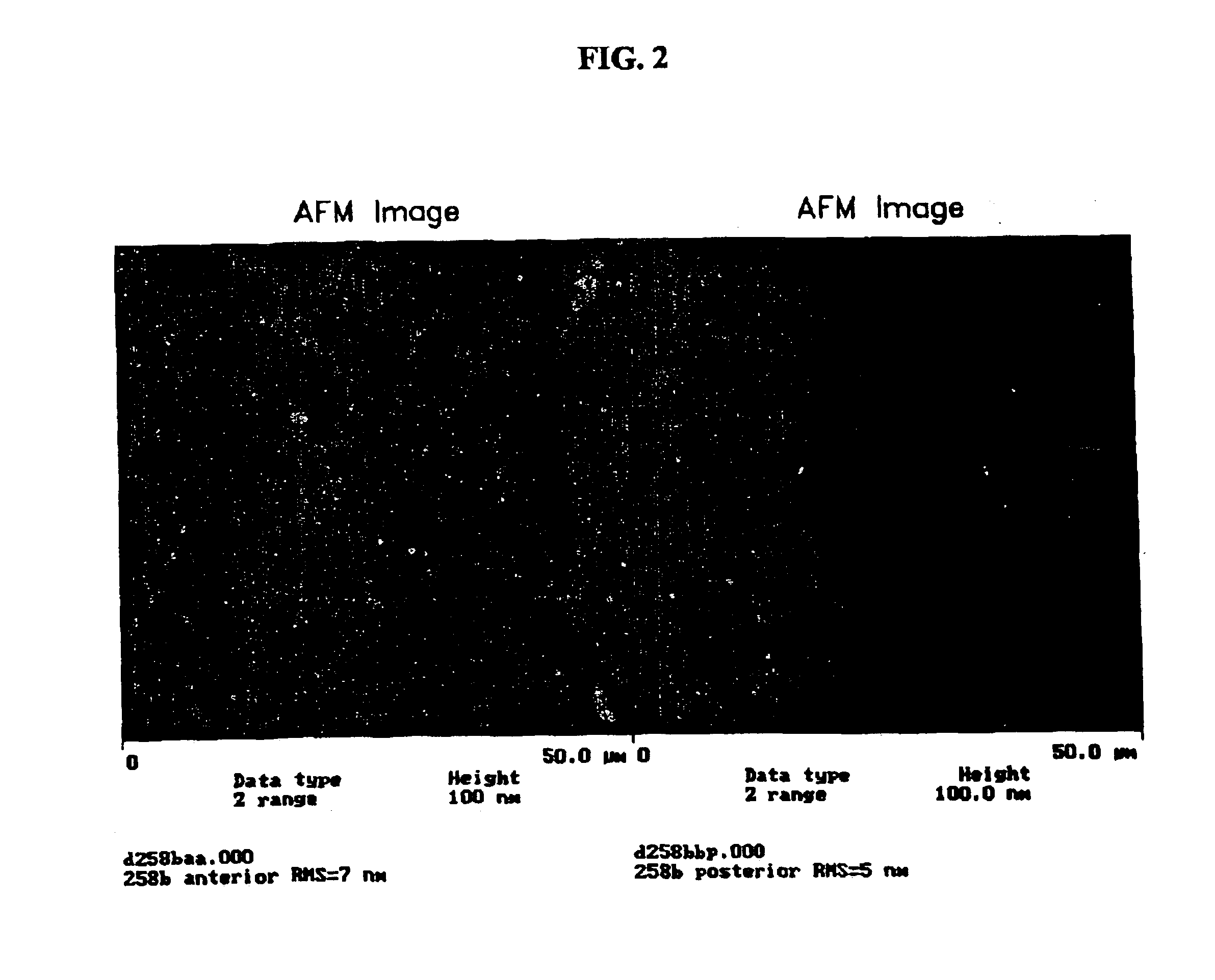Surface treatment for silicone hydrogel contact lenses comprising hydrophilic polymer chains attached to an intermediate carbon coating
- Summary
- Abstract
- Description
- Claims
- Application Information
AI Technical Summary
Benefits of technology
Problems solved by technology
Method used
Image
Examples
example 1
[0139]This example discloses a representative silicone hydrogel lens material used in the following Examples as a coating substrate. The formulation for the material is provided in Table 1 below.
[0140]
TABLE 1ComponentParts by WeightTRIS-VC55NVP30V2D2515VINAL1n-nonanol15Darocur0.2tint agent0.05
[0141]The following materials are designated above:
[0142]
TRIS-VCtris(trimethylsiloxy)silylpropyl vinyl carbamateNYPN-vinyl pyrrolidoneV2D25a silicone-containing vinyl carbonate as previouslydescribed in U.S. Pat. No. 5,534,604.VINALN-vinyloxycarbonyl alanineDarocurDarocur-1173, a UV initiatortint agent1,4-bis[4-(2-methacryloxyethyl)phenylamino]anthraquinone
[0143]Employing this material, a typical process for preparing a contact lens prior to its surface modification according to the present invention is as follows. Silicone hydrogel lenses made of the above formulation were cast-molded from polypropylene molds. Under an inert nitrogen atmosphere, 45-μl of the formulation was injected onto a cle...
example 2
[0144]Table 2 below represents a polyurethane silicone hydrogel formulation used in the following examples as a coating substrate.
[0145]
TABLE 2ComponentParts by WeightUrethane crosslinking resin55TRIS20DMA25UV Absorber0.5n-Hexanol12Irgacure-8190.5IMVT150ppm
[0146]The following materials are designated above:
[0147]
TRIStris(trimethylsiloxy)silyipropyl methacrylateDMAN,N-dimethylacrylamideUrethanea silicone-containing crosslinking resin aspreviously described in U.S. Pat. No.5,034,461.Irgacure-819a UV initiatorIMVTa tint agent, namely 1,4-bis[4-(2-methacryloxyethyl)phenylamino]anthraquinone
example 3
[0148]Table 3 below represents a polyfumarate silicone hydrogel formulation used to make a lens in the following examples as a coating substrate.
[0149]
TABLE 3ComponentParts by WeightF2D2020TRIS40DMA40n-Hexanol5DAROCUR-11730.5IMVT150ppm
[0150]The following materials are designated above:
[0151]
TRIStris(trimethylsiloxy)silyipropyl methacrylateDMAN,N-dimethylacrylamideF2D20a silicone-containing crosslinking resin as previouslydescribed in U.S. Pat. Nos. 5,374,662 and5,496,871.Darocura UV initiatorIMVTa tint agent, namely 1,4-bis[4-(2-methacryloxyethyl)phenylanimo] anthraquinone
PUM
| Property | Measurement | Unit |
|---|---|---|
| Volume | aaaaa | aaaaa |
| Fraction | aaaaa | aaaaa |
| Fraction | aaaaa | aaaaa |
Abstract
Description
Claims
Application Information
 Login to View More
Login to View More - R&D
- Intellectual Property
- Life Sciences
- Materials
- Tech Scout
- Unparalleled Data Quality
- Higher Quality Content
- 60% Fewer Hallucinations
Browse by: Latest US Patents, China's latest patents, Technical Efficacy Thesaurus, Application Domain, Technology Topic, Popular Technical Reports.
© 2025 PatSnap. All rights reserved.Legal|Privacy policy|Modern Slavery Act Transparency Statement|Sitemap|About US| Contact US: help@patsnap.com



